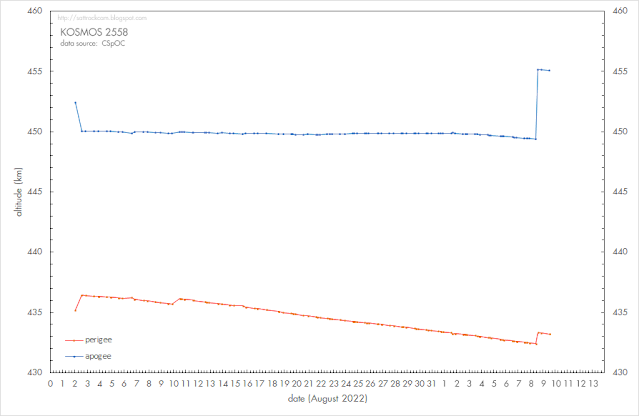 |
click map to enlarge
|
On 24 September 2022 at 21:53 UT, an ULA Atlas Delta IV Heavy (the last to be launched from Vandenberg) will launch from Vandenberg SFB Launch Complex 6 as NROL-91, carrying a classified payload into Low Earth Orbit for the NRO.
The launch is in southernly direction. The locations of the four hazard areas from the published Navigational Warnings (see map above and text below) are consistent with launch into an orbital inclination of 73.6 degrees, which is similar to NROL-71 from January 2019 that launched USA 290 (2019-004A).
So the NROL-91 payload likely is a sister ship to USA 290.
Below is Navigational Warning HYDROPAC 2592/22 for the launch (note that there appears to be a clerical error in the first coordinate of area C):
122224Z SEP 22
HYDROPAC 2592/22(GEN).
EASTERN PACIFIC.
CALIFORNIA.
1. HAZARDOUS OPERATIONS:
A. 242020Z TO 242347Z SEP, ALTERNATE
2020Z TO 2347Z DAILY 25 THRU 27 SEP
IN AREA BOUND BY
33-53.00N 120-23.00W, 34-28.00N 120-40.00W,
34-39.00N 120-40.00W, 34-39.00N 120-35.00W,
34-27.00N 120-25.00W, 33-55.00N 120-18.00W.
B. 242020Z TO 242345Z SEP, ALTERNATE
2020Z TO 2345Z DAILY 25 THRU 27 SEP
IN AREA BOUND BY
25-18.00N 117-07.00W, 25-12.00N 117-27.00W,
26-35.00N 117-53.00W, 26-41.00N 117-33.00W.
C. 242020Z TO 242345Z SEP, ALTERNATE
2020Z TO 2345Z DAILY 25 THRU 27 SEP
IN AREA BOUND BY
00-17.00S 121-28.00W, 00-07.00S 110-21.00W,
03-24.00S 109-33.00W, 03-24.00S 110-21.00W.
D. 242242Z TO 250133Z SEP, ALTERNATE
2242Z TO 0133Z DAILY 25 THRU 27 SEP
IN AREA BOUND BY
17-57.00N 140-23.00W, 06-13.00N 137-52.00W,
06-30.00N 136-25.00W, 18-15.00N 138-53.00W.
2. CANCEL THIS MSG 280233Z SEP 22.//
A second Navigational Warning for this launch, NAVAREA XII 695/22, is identical.
The locations of the first three hazard areas A to C from the
Navigational Warning
are indeed very similar to those for NROL-71 in 2019: compare for example to
this map for NROL-71 from this december 2018 post:
 |
NROL-71 from January 2019. click to enlarge
|
Area
D, the upper stage deorbit area, is situated slightly more
south and is a bit more elongated than it was for NROL-71, for unclear
reasons. The upper stage deorbit happens at the end of the first revolution. The deorbit burn might be visible from central Asia around 23:10-23:20 UTC.
In 2019, NROL-71 was launched into a 395 x 420 km, 73.6 degree inclined non-sun-synchronous orbit and I expect the orbit of the NROL-91 payload to be very similar.
Here is my pre-launch orbital estimate for the NROL-91 payload based on this assumption:
NROL-91 for launch on 24 Sep 2022 at 21:53:00 UT
1 70001U 22999A 22267.91180556 .00000000 00000-0 00000-0 0 06
2 70001 073.6000 044.7175 0018421 155.1634 324.7303 15.53162541 00
If NROL-91 indeed launches at 21:53 UT on the 24th, the orbital planes of the payload and USA 290 will end up at a 90-degree angle to each other, as can be seen in the polar view below:
 |
polar view of the orbital plane relative to that of USA 290. Click to enlarge
|
If the launch is scrubbed on the 24th, and if indeed this specific orbital plane at 90-degree angle to that of USA 290 is aimed for, the launch time will shift ~13 minutes earlier each day.
USA 290 at the time was widely believed to be a new generation electro-optical reconnaissance (IMINT) satellite, a follow-on on the KH-11 ENHANCED CRYSTAL program. That it was launched, as NROL-91 will be, in a non-sun-synchronous orbit is odd though, for an optical reconnaissance satellite.
One really wonders why the sun-synchronous polar orbit typical for such missions (and typical for earlier generation KH-11 EVOLVED ADVANCED CRYSTAL missions) was dropped in favour of this new 73.6 degree orbital plane. What is the advantage of this new orbital configuration? Or are USA 290 and NROL-91 perhaps not electro-optical systems, but something else?










